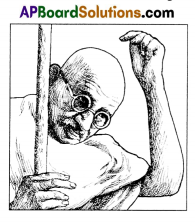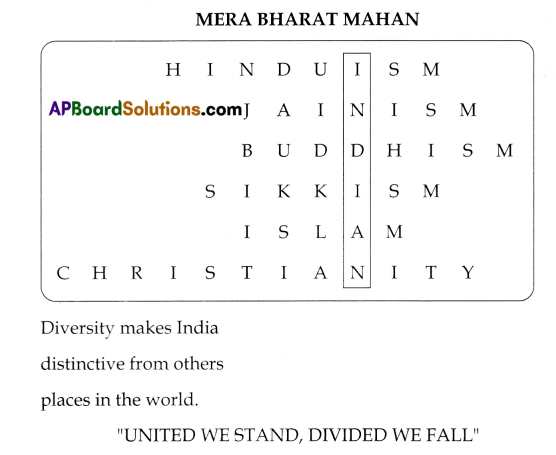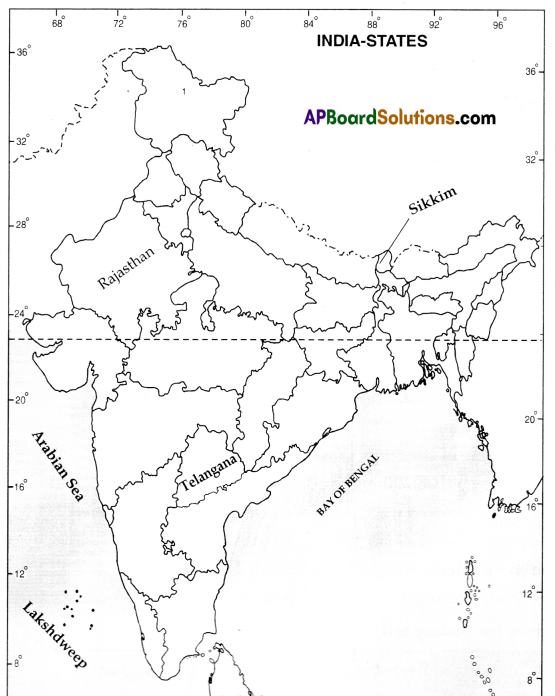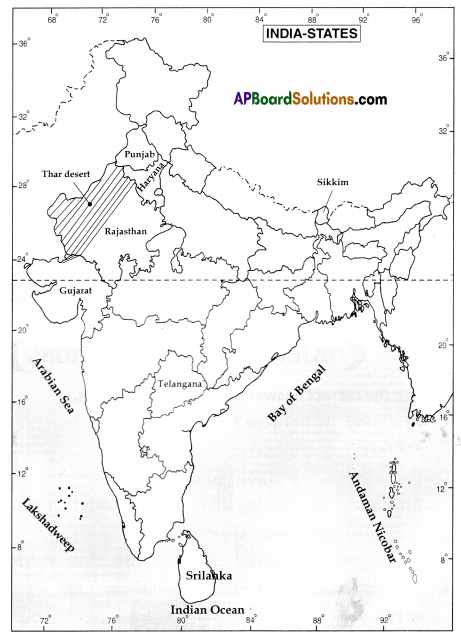Telangana SCERT TS 6th Class Social Guide Pdf 15th Lesson Diversity in Our Society Textbook Questions and Answers.
TS 6th Class Social 15th Lesson Questions and Answers -Diversity in Our Society
(Improve Your Learning)
Question 1.
Give any two examples that reveal diversity in your neighbourhood. (Conceptual understanding)
Answer:
1. A Christian family and a Muslim family are our neighbours.
2. The Christian family goes to church every Sunday for prayer Muslim family goes to mosque on every Friday for namaz.
3) Muslim family members speak Urdu, Christian family speaks Telugu Along with the above said differences, there is diversity in their dress, culture, tradition and food habits.
Question 2.
Prepare a table of similar items of different religions which depict unity. (information skills)
Answer:
The following table shows the similar items of different religions which depict unity.
| Religion | Worshipping Centre | Holy book | Similarities that depict unity |
| 1. Hinduism | Temple | Bhagavad-gita | God is one maintaining |
| 2. Jainism | Temple | Angas | good character worshipping |
| 3. Sikkism | Gurudwara | Gurugrandh Saheb | with pure mind leading |
| 4. Buddhism | Monastery | Tripitakas | pious life Love thy neighbour |
| 5. Islam | Mosque | Quran | as thouself Service to mankind is service to God. |
| 6. Christianity | Church | Bible |
‘The ultimate goal of all religions is brotherhood towards others.
Question 3.
How do you say that national sports meet develops unity in diversity? (Appreciation and Sensitivity)
Answer:
- Every year our country is conducting National Sports.
- People from various parts of the country are participating in the National sports.
- During the period of National Sports, all the people come closure and exchange their ideas, culture, tradition, habitation, food habits, language. etc.
- The idea in conducting National Sports is to develop brotherhood, unity and integrity among the people.
- It also helps the people to cooperate with each other and enrich the idea that “WE ARE ONE”.
![]()
Question 4.
Prepare a list of festivals that are celebrated in your locality. Which of them are shared by members of different regional and religious communities? (Appreciation and Sensitivity)
Answer:
- The religious festivals are Dussehra, Pongal, and Ramzan. Christmas and Diwali. These festivals are celebrated in our locality.
- The national festivals are Independence Day and Republic Day.
- The national festivals are celebrated together by all regions and religious communities.
Question 5.
In what ways does living in India with its rich heritage of diversity add to your life? (Appreciation and Sensitivity)
Answer:
living in India with its rich heritage of diversity adds the following things:
- Making friendship with different people of different areas.
- Eating dillerent kinds ol food.
- Celebrating different festivals.
- Following different traditions,
- learning different languages.
Question 6.
Read the last para of page 132 (When Britishers…….oppose them) and comment on It. (Reading the text (given), understanding and interpretation)
When Britislers ruled in India, women and men from different cultures, religions and regional backgrounds came together to oppose them.
Answer:
- India is a multi-cultured society. Here the people are different from each other in many ways.
- Not only do they look different but they might also belong to different regional, cultural or religious backgrounds.
- All these people with different backgrounds, religions and cultures came together to oppose publishers administration and to make India so interesting and so diverse.
Question 7.
Collect pictures and contributions of freedom fighters of different regions and prepare a book containing their biographies. (information Skills)
Answer:
Bal Gangadhar Tilak: Bal Gangadhar Tilak (1856.1920) was a well-known Indian nationalism in the early part of the 20th century when the trend of Indian Independence was mostly guided By Extremism, Tilak became the uncrowned king.
‘Tilak was one of the first and strongest proponents of Swaraj and he was also considered the father of Hindu Nationalism. Tilak was credited to be the first nationalist leader who sought close contact with the masses In this respect he was the precursor of Mahatma Gandhi.

M.K. Gandhi: Mohandas Karamchand Gandhi. popularly known as Mahatma Gandhi, led the nation through the Indian, freedom struggle with his ideologies of Ahimsa or Non-violence, Civil Disobedience Movement and Swaraj. He was the leader of Indian National Congress and initiated the Satyagraha movement. He was
honoured with the title Mahatma, meaning Great Soul, by Rabindranath Tagore.
Mahatma Gandhi is Known a Father of Nation and played a key role in the Indian freedom struggle. Mahatma Gandhi’s main contribution lay in the fact that he bridged the gulf between the intelligents and the masses and widened the concept of Swaraj to include almost every aspect of social and moral regeneration. Paving tribute to Mahatma Gandhi on his death, famous scientist Albert Einstein said. ‘Generations to come will scarcely believe that such a man walked on the earth in flesh and blood’.

C. RajagopalaChari: Popularly known as “Rajaji”. “C. Rajagopalachari. the first Indian Governor General of Independence of India, was an ardent patriot, a pioneering social reformer, incisive thinker, profound scholar and author, He was also an eminent statesman and able administrator, He personified the ideal of simple living and high thinking. In the words of Jawaharlal Nehru, ‘Rajaji represents fundamentally the highest type of mind in India.”

Question 8.
Design a pamphlet giving illustrations that depict unique features of India’s unity in diversity. (Appreciation and Sensitivity)
Answer:

Question 9.
Fill in the following table: (Information Skill)
Answer:
| Item | Myself | Friend (Male) ……………….. | Friend (Female)…………………. |
| 1. Food | Rice | Rice | Roti |
| 2. Dress | Saree | Pant/Shirt | Salwar Kameerz |
| 3.House | Pucca | Pucca | Pucca |
| 4. Mother Tongue | Telugu | Kannada | Hindi |
| 5. Religion | Hindu | Chiristain | jain |
| 6. Festivals | Sankranti | Christmas | Mahaveer Jayanti |
| 7. Any other (Dance style) | Kuchipudi | Breakdance | Dandia |
Do you consider differences in the above items as obstacles to continue your friendship? Justify.
Answer:
The above-said differences are not obstacles to continue our friendship.
![]()
Question 10.
Locate the following in India map. Mapping skills)
a) Titar desert
b) Sikkim
c) Bihar
d) Andhra Pradesh
e) Telangana
(f) Punjab
Answer:

Question 11.
Read the para under the title How does diversity come about?’ And comment on it. How does diversity come about?
People of all times went about in search of new lands and settled at new places. Sometimes they went to trade. Some other times they left their homes due to floods, drought, epidemics, wars and conflicts etc. They brought their languages, religions and cultures to the new place and tried to follow them in the new place also. Gradually, they mixed with the people of those areas, adopted many of their things and also taught many of their own things to them. In the following section, we will see how the life of people in different places evolves with diversity.
Answer:
1. The above-mentioned paragraph describes the reasons and ways led to diversity in India.
2. People migrated from one place to other in search of new lands or to start trading.
3. Sometimes, they left the place due to epidemics, wars, floods etc., and started following the customs and traditions of new place.
4. In course of time, they got mixed up with people of those areas and taught many things of their own.
5. Finally, we can say that huge diversity of India is due to its geography religions, customs etc.
Intext Questions
Questions is given in Box P. No. 129
Question 1.
Can you list the differences between the two – student Suman and vegetable Suman.
Answer:
| Student Suman | Vegetable Suman |
| 1) Native of Madanapalle | 1) Native of Bihar settled in Madanapalle. |
| 2) Mother tongue is Telugu | 2) Mother tongue is Hindi |
| 3) Can speak English also. | 3) Can speak Telugu a little. |
| 4) Goes to school. | 4) Assists his mother in vegetable shop. |
Question 2.
Find out about the festivals and food of the people of Bihar (or any another state)
Answer:
The following table shows the festivals celebrated by the people of Tamilnadu.
| Festival | Food |
| 1) Pongal | Sweet Pongal with rice |
| 2) Jallikattu – Bull fight | Community meals |
| 3) Navaratri | Ravva Kesari, Pulihora, Garclu |
| 4) Tamil New Year’s Day | Neem flower dish and Payasam |
Question 3.
What festivals would he celebrate? What kind of food would student Suman eat?
Answer:
| Festival | Food |
| 1) Ugadi | Ugadi Pachhadi |
| 2) Varalakshrni Vratam | Poornalu, garelu |
| 3) Vinavaka Chaviti | Undrallu |
| 4) Dussehra | Pulihora, garelu |
| 5) Diwali | Any sweet |
| 6) Sankranti | Pongali, Ariselu |
Question 4.
‘What kind of a house would Vegetable Suman and student Suman be living in?
Answer:
VegetableSuman lives in a small house with a single room where as Student Suman lives in a duplex house.
Question 5.
‘You would have noticed that there are other kind of differences between the two vegetables Suman did not go to school but sold vegetables. Why do you think he was not able to go to school?
Answer:
- Vegetable Suman s mother is a vegetable seller.
- Her income is not sufficient for their livelihood.
- Because of her poverty, she is not able to send her son to school.
Question 6.
If Vegetable Suman wanted to go to school what problems would he have faced?
Answer:
- Vegetable Suman assists his mother in selling vegetables.
- If he wants to go to school, h may face language problem because vegetable Suman is a Bihari.
- He may suffer from inferiority complex.
Questions given in Box P. No. 130
Question 7.
List all the food items you eat but your grandparents wouldn’t have known:
Answer:
| Items | Where did they come from? | |
| Food | Pizzas, burgers. noodles, pastries | From fast food centres |
| Dress | Jeans, Rayon, Nylon | From fabric factories |
| Games | Video games | From new technology |
| Festivals | Women’s Day, Mother’s Day, etc. | From Western Culture. |
Question 8.
Look at a map of India showing states and union territories. Locate Telangana, Rajasthan and Sikkim.
Answer:


Questions given in Box P. No. 133
Question 9.
India’s national anthem, composed by Rabindranath Tagore, another expression of the unity of India. In what way does the national anthem describe this unity?
Answer:
- Indian National Anthem Janaganamana composed by Rabindranath Tagore.
- By identifying to a particular people’s culture and aspirations. the National Anthem has contributed to the development of Unit’ in Diveritv.
(Additional Questions)
Question 1.
Read the information carefully and answer the questions given.
Answer:
| Telangana | Rajasthan | Sikkim | |
| Language | Telugu | Rajasthani | Hindi/ 11 languages |
| Region | Deccan Plateau | Desert | Himalayas |
| Plantation | Food crops, Cash crops like paddy, pulses, cereals, etc. | Only grass | Maize, paddy, wheat, ginger, cardamom etc. |
| tourist Centres | Hyderabad, Warangal, Bhadrachalam | jaisalmer, Bikaner, Jodhpur. | Kandienjunga |
1. How many languages are spoken by the people of Sikkim?
Answer:
Eleven languages.
2. In which region do we find Telangana?
Answer:
In Deccan Plateau
3. Mention some of the crops grown in Sikkim.
Answer:
Maize, paddy. wheat, ginger, cardamom etc.
4. Name the desert in Rajasthan. Which crops grow in the desert?
Answer:
Thar desert is in Rajasthan. Only grass grows in it.
5. Name some interesting places to visit in Telangana
Answer:
Hyderabad, Warangal and Badrachalam are important tourist centres in Telangana.
![]()
Question 2.
What does the picture tell :

The picture shows Jaisalmer Fort of Rajasthan. It is a centre of many religions as many traders coming from Iran and Afghanistan or going to those countries used to pass through this centre.
(Reflection On Contemporary Issues And Questioning)
Question 3.
What are the factors that bind us together in India?
Answer:
- Single citizenship
- Our historical legacy.
- Single constitution
- National parties.
- Some institutional arrangements like IAS, IPS etc,.
(Mapping Skills)
Point out the following states on the map of India.
1) Telangana
2) Sikkim
3) Rajasthan
4) Haryana
5) Punjab
6) Gujarat
7) Thar Desert
Answer:

Two Marks Questions
Question 1.
How many stales do we have in India?
Answer:
We have 29 states in India including Telangana.
Question 2.
What is inequality?
Answer:
Inequality is a state in which the resources and the opportunities are not available to all the people on equal grounds.
Question 3.
Where is the Thar desert?
Answer:
Thar desert is situated on the border of India and Pakistan.
Question 4.
Name some cities of Rajastan.
Answer:
jaisalmer, Bikaner, Jodhpur etc are some cities of Rajastan
Question 5.
Which city in Rajastan is famous for sweets and savouries?
Answer:
Bikaner is famous for sweets and savouries.
![]()
Question 6.
Where is Sikkim situated?
Answer:
Sikkim is a small state situated in the eastern parts of the Himalayan mountains,
Question 7.
What are the crops grown in Sikkim?
Answer:
People grow crops like maize, paddy, wheat, cardamom, ginger etc. in Sikkim.
Question 8.
When was Sikkim become a part of India?
Answer:
In 1975 Sikkim became a part of India
Question 9.
What do you mean by unity in Diversity?
Answer:
Though India has multiple diversities it continues with unity. This spirit i known as
“Unity in Diversity.
Objective Type Questions
Question 1.
What is our National game? ( )
A) Cricket
B) Hockey
C) Kabaddi
D) Chess
Answer:
B) Hockey
Question 2.
The cattle of ……………………. region give very good milk. ( )
A) Gujarat
B) Sikkim
C) Tamilnadu
D) Assam
Answer:
D) Assam
Question 3.
……………….. remains cold throughout the year ( )
A) Rajasthan
B) Kerala
C) Orissa
D) Sikkim
Answer:
A) Rajasthan
![]()
Question 4.
…………………. is an example for Vasudhaika kutumbam”. ( )
A) Pakistan
B) Sri Lanka
C) India
D) America
Answer:
C) India